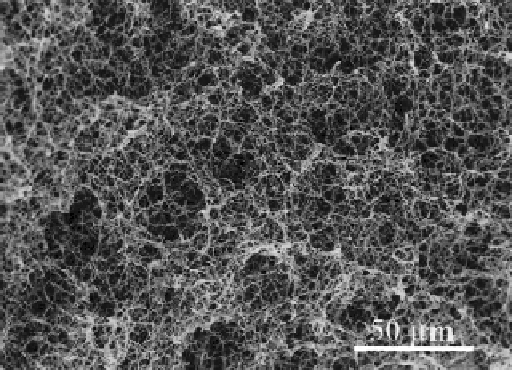Biomedical Engineering Reference
In-Depth Information
Figure 13.3.
Scanning Electron Micrograph of PLLA scaffolds synthesized from 2.5% (w/v)
PLLA/THF solution at a gelation temperature of 8 °C by phase separation. Reprinted from Ma
PX, Zhang R. Synthetic nano-scale fi brous matrix. 1999;46(1):60-72. Copyright © 1999 J Wiley.
Reprinted with permission of John Wiley & Sons Inc.
Nanofi brous poly(L-lactic acid) (PLLA)] scaffolds with high porosity (98.5%)
have been synthesized by Ma and Zhang [62] (Figure 13.3). They demonstrated
the gelation behavior of PLLA in different solvents as well as at variable tem-
peratures; with gelation occurring readily in tetrahydrofuran (THF) and below
17 °C and platelet like structure at higher temperatures due to crystal nucleation
and growth process. In another study, Hua et al. synthesized PLLA scaffolds with
an interconnected porous structure by liquid-liquid phase separation of ternary
PLLA-water-dioxane solution [63]. The synthesized scaffolds resulted in effective
cell penetration and demonstrated potential in cartilage tissue engineering. Yang
et al. synthesized highly porous and fi brous PLLA matrices [64] that resembled
the natural ECM in the body with fi ber diameter ranging from 50 nanometer(nm)
to 350 nm. They demonstrated the differentiation of nerve stem cells on these
nanofi brous PLLA scaffolds and hence their potential use of PLLA matrix in
nerve tissue engineering.
Thermally-induced phase separation (TIPS) has been recently used exten-
sively for the synthesis of interconnected and porous membranes. In this tech-
nique, homogenous polymer solution prepared at a higher temperature is
converted into two phases (polymer rich phase and polymer lean phase) by
changing the temperature [65]. Huang et al. used TIPS to synthesize poly(lactide-
co - glycolide)/nano - hydroxyapatite (PLGA/NHA) scaffolds. Their results
demonstrated enhanced mesenchymal stem cell (MSC) growth and proliferation
on regular and highly interconnected porous PLGA/NHA scaffolds {100-150
micro meters (
m)} as compared on PLGA only scaffolds thereby establish-
ing the potential of TIPS synthesized PLGA/NHA scaffolds in bone tissue
engineering [66].
μ

Search WWH ::

Custom Search